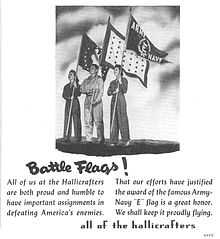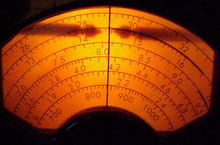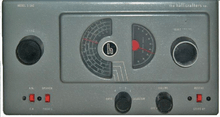Hallicrafters
 | |
| Industry | Electronics |
|---|---|
| Founded | 1932 |
| Founder | William J. Halligan |
| Headquarters |
|
| Products | radio equipment |
Number of employees | 2,500 (1952) |
The Hallicrafters Company manufactured, marketed, and sold radio equipment beginning in 1932. The company was based in Chicago, Illinois, USA.
History
William J. Halligan founded his own radio manufacturing company in Chicago in late 1932. Prior to this, he had been involved in radio parts sales for some years but decided that the time was right for a handcrafted amateur radio receiver - the company name being a combination of Halli(gan) and (hand)crafters.
The new company was located at 417 State Street and immediately ran into patent difficulties when RCA decided to sue them for building radio sets without an RCA patent license. An opportunity came to purchase the concern of Silver-Marshall Inc. in 1933 and, with it, an RCA patent license as the most valuable asset.
In order to meet their financial obligations, Hallicrafters produced radios for other manufacturers until they were financially able to begin production of their own line of communications receivers, starting with the SX-9 'Super Skyrider', in late 1935.
By 1938, Hallicrafters was doing business in eighty-nine countries and manufactured the most popular sets in the USA. That year, the company began to produce radio transmitters. With the outbreak of World War II, the company prepared for wartime production, and was responsible for new designs and innovations for use by the U.S. troops; probably the best-known were the HT-4/BC-610 and related equipment used in the military SCR-299 communications package.

Production of Ham radio gear and other items was suspended until 1945. After the war, focus was again on consumer electronics, including radio phonographs, AM/FM receivers, clock radios and televisions.[1]
The boom years for Hallicrafters were from 1945 to 1963, during which the company produced equipment considered by many to be superbly designed, including the famous S-38 receiver, which received a cosmetic "makeover" by industrial designer Raymond Loewy.

In 1952 Hallicrafters' main plant in Chicago housed general offices and the factory and was a block long. In addition to the main plant was a 3-story building of 72,000 square feet (6,700 m2) two blocks away, a 1-story coil plant of 12,000 square feet (1,100 m2) on Chicago's north side, and 150,000 square feet (14,000 m2) of production and storage space in three other buildings within a five-mile radius of the main plant. The company employed 2,500 people.[1]
In 1966 Halligan sold the company to the Northrop Corporation and Halligan family involvement ended. Northrop ran the company until the early 1970s, but by this time, fierce Japanese competition was putting pressure on the US domestic electronics market. Northrop sold the company name (but kept the factory, by then located in Rolling Meadows, a Chicago suburb) in 1975, bringing non-military electronics production to an end. The Hallicrafters plant became Northrop Corporation's Defense Systems Division at that time.
The name and assets of Hallicrafters were traded over the following years, even though there were no products bearing the name. Since around 1988, the remaining assets and rights to the 'Hallicrafters' name & logos have been held by court-appointed trustees.[2] (note: one known 1980s product bearing the Hallicrafters name does exist - a 4-line plus intercom *telephone* [3])
Much Hallicrafters equipment is still in common use by collectors and vintage amateur radio enthusiasts, and widely available on the used market. Due to the transformerless design of many tube radios of this period, an isolation transformer should be used with any radio that has not had safety wiring modifications.
Equipment
Pre war
Some of the more well-known Hallicrafters equipment from the pre-war period include:
- the Super Skyrider, model SX-9 (1936), equipped with a large German silver tuning dial, and one of the first receivers to use the new "all-metal" vacuum tubes.
- the Ultra Skyrider, model SX-10 (1936), able to tune what were then sometimes referred to as "UHF" bands (frequencies above 30 megahertz).

- the Skyrider Diversity (1938), actually two complete multi-tube receivers side-by-side. This enabled the operator to connect two different antennas to the set and counteract the effects of fading. A huge set and today, one of the most sought-after models.
- the HT-4 Transmitter (1938), an efficient high-performance transmitter for the Ham bands, later to become famous in World War II as the BC-610. It was sold well into the late 1940s.
- the Skyrider 23, model SX-23 (1939), famous for its innovative "art-deco" cabinet design.
- the Super Skyrider SX-28, (1940–43) and SX-28A (1944–46), one of the most popular Hallicrafters receivers. Its design was state of the art for the time, and featured excellent external styling. The SX-28 was notable for audio that sounded better than many expensive home receivers. It is still easy to find today, and remains a favorite of collectors.
Wartime
- SCR-299/399 (1942), complete mobile HF station on frequencies from 2-8 MHz (and 1-18 MHz using conversion kits), entire unit came in a K-51 truck except Power Unit PE-95 which was in a K-52 trailer.
- SCR-543/593 (1944), also sold after the war as the model BC-669-B, it was a medium range (25 - 100 nm) portable vehicular and ground sets for CAC; SCR-593 was portable being the receiver portion only.
Post war
Postwar Hallicrafters models include:

- Model S-38 (1947), a "beginner's" receiver. Simple and inexpensive, yet it introduced many to shortwave listening.
- Model SX-42 (1948), a massive receiver featuring the new FM band. It, too, was popular for its appearance, styled by the famous industrial designer Raymond Loewy. The SX-42 was a dual-purpose receiver; it provided not only shortwave reception, but standard AM broadcast and FM reception.
- Model SX-62 (1949), an updated version of the SX-42, with improved circuitry and cabinet styling.
- Model SX-73 (1952), a professional receiver aimed mainly at the military market, but also available on the civilian market. It was Hallicrafters' answer to the Hammarlund SP-600 Super-Pro.
- Model HT-20 (1952), an all-purpose shortwave transmitter, featuring multi-band switching.
- Model S-85 (1954-5), general coverage (560 kHz-30 MHz/4 bands), single conversion), amateur bandspread (10-80m), dual tuning dials, RF and audio gain controls, beat frequency oscillator (controllable frequency), transmit/receive switch, sold for $119.95 at Sears, Roebuck and Co.
- Model SX-88 (1954), at the time, the finest commercial receiver available. The SX-88 was designed for the operator for whom cost was not a concern, and featured outstanding performance and appearance. Less than 100 are known to exist, as such they are highly prized by ham radio operators.
- Model SX-96 (1954-5), general coverage (560 kHz-30 MHz/4 bands), double conversion, S-meter, crystal filter, amateur bandspread (10-80m), dual tuning dials, RF and audio gain controls, beat frequency oscillator (controllable frequency), transmit/receive switch, sold for ~$169.

- Model HT-30 (1954), The first single-sideband transmitter made by Hallicrafters.
- Model SX-100 (1955), a double conversion superhet general coverage receiver with SSB capability and bandspread tuning for the 10-80 meter amateur bands.
- Model SX-101 (1956), the first ham band only receiver built by Hallicrafters
- Model HT-32 (1957), the most popular SSB transmitter made by Hallicrafters
- Model HT-37 (1959), a lower cost version of the HT-32, using phasing type SSB generation. A well-designed transmitter, and many are still in service today.
- Model SX-110 (1959-1962) A large receiver for the Amateur Radio (Ham) market.
- Model SX-115 (1961), yet another large receiver for the Amateur Radio market. It featured a huge central dial, and is another model prized by collectors.
- Hallicrafters SX-117 (1965) One of the most advanced ones for its time. Had several accessories.
- Model HT-44 (1962) transmitter with continuous wave (CW) and single-sideband (SSB) capability on 10 to 80-meter amateur radio bands. The HT-44 was the matching transmitter for the SX-117 receiver.
See also
- Collins Radio
- Vintage amateur radio
- Hammarlund
- National Radio Company
- Signal Corps Radio
- Radio Shack (Halligan was an early employee)
References
- ↑ 1.0 1.1 Chuck Dachis, The History of Hallicrafters.
- ↑ Dachis, Chuck (1999). Radios By Hallicrafters. Schiffer Publishing, Atglen(USA).
- ↑ http://www.amazon.com/HALLICRAFTERS-412-LINE-DESK-PHONE/dp/images/B005FNVHI6
- de Hensler, Max. The Hallicrafters Story. Charleston, West Virginia: ARCA Press, 1988
- Moore, Raymond. Communications Receivers, Fourth Edition. La Belle, Florida: RSM Communications, 1997
- Osterman, Fred. Shortwave Receivers Past and Present. Reynoldsburg, Ohio: Universal Radio Research, 1998
External links
| Wikimedia Commons has media related to Hallicrafters radios. |